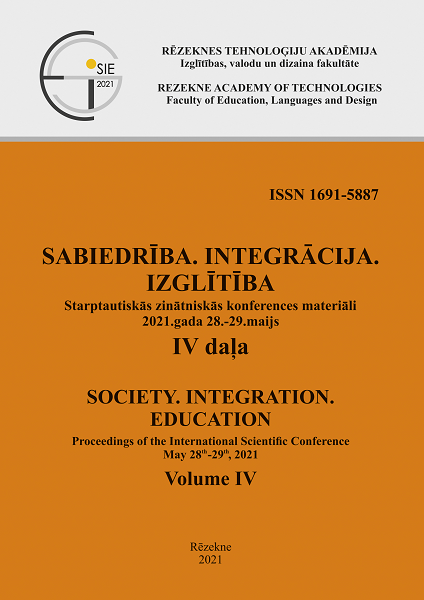MEANS AND METHODS OF PREVENTION AND CORRECTION OF DEVIANT BEHAVIOR OF ADOLESCENTS BY MEANS OF ART EDUCATION AND CULTURAL STUDIES
DOI:
https://doi.org/10.17770/sie2021vol4.6206Keywords:
art education, deviant behavior, art pedagogyAbstract
The article deals with the tasks of using art education in the process of organizing training. The research is devoted to the disclosure the pedagogical potential of art education. The research reveals the directions of art education and cultural studies based on theoretical analysis. The study reveals the effect of art education and cultural studies in the correction of deviant and delinquent behavior of young people and adolescents. The article summarizes the available means and techniques of art education, such as music, art, dance, theater and many others. The study analyzes the principles of choosing specific art forms in the educational process. The study demonstrates that book therapy techniques can be used not only as a preventive program, but also as an early intervention program and a program for correcting deviations. The article reveals the sequence of methodological steps when using the techniques of book therapy. The study of the use of techniques of art education and cultural studies in the correction of deviant and delinquent behavior reveals the effectiveness of the use of various genres of fine art. The creation of a work of art contributes to the socialization of the student, reveals the creative potential, contributes to the process of emotional and social comfort of the student. The analysis of the practices of educational organizations shows the importance of professional experience in the field of art education, demonstrates the discovery of the most effective in the aesthetic sense techniques of artistic processing of material Educational organizations make extensive use of dance art techniques. Musical activity allows adolescents to achieve a certain level of cheerfulness. This is recorded by experimental studies in various countries using music therapy techniques in the educational process. Dance practices are also used by educational organizations. Dance and movement therapy suppresses aggression, replaces destructive forms of behavior with socially adequate forms of expression and the development of alternative action strategies.
References
Ajzen, I., Fishbein, M. (1980). Understanding attitudes and predicting social behavior. Englewood Cliffs, NJ: Prentice Hallю
DiCenso, M., Alba, B., Thomas, H., Devlin, M. C., Goldsmith, C.H., Willan, A., Singer, J., Marks, S., Watters, D., Hewson, S. (1997). Evaluation of an educational program to prevent adolescent pregnancy. Health Education and Behavior, 24, 300-312.
Douglas, K., Barth, R.P., Leland, N., Fetro, J.V. (1991). Reducing the risk: Impact of a new curriculum on sexual risk-taking. Family Planning Perspectives, 23, 253-63.
Ellickson, P. L., Bell, R.M. (1990). Drug prevention in junior high: A multi-site longitudinal test. Science, 247, 1299-1305.
Ennett, S.T., Tobler, N.S., Ringwalt, C.L., Flewelling, R.L. (1994). How effective is drug abuse resistance education? A meta-analysis of Project DARE outcome evaluations. American Journal of Public Health, 84, 1394-1401.
Janz, N.K., Becker, M.H. (1984). The Health Belief Model: A decade later. Health Education Quarterly, 11, 1-47.
Malvin, J.H., Moskowitz, J.M., Schaeffer, G.A., Schaps, E. (1984). Teacher training in affective education for the primary prevention of adolescent drug abuse. American Journal of Drug and Alcohol Abuse, 10, 223-235.






